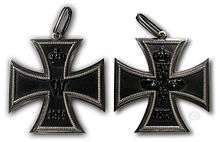Iron Cross
The Iron Cross (German: ![]()


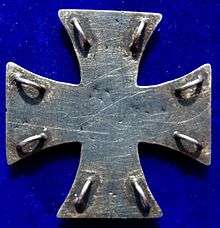

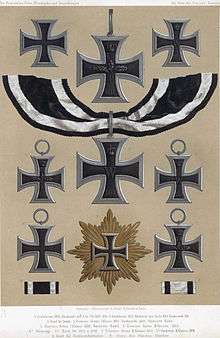
The design of the cross symbol was black with a white or silver outline, was ultimately derived from the cross pattée of the Teutonic Order, used by knights on occasions from the 13th century.[2]
The Prussian Army black cross pattée was also used as the symbol of the succeeding German Army from 1871 to March–April 1918, when it was replaced by the Balkenkreuz. In 1956, it was re-introduced as the symbol of the Bundeswehr, the modern German armed forces (with the "ends" of the white border removed, as in the Balkenkreuz of 1918).
Black Cross emblem
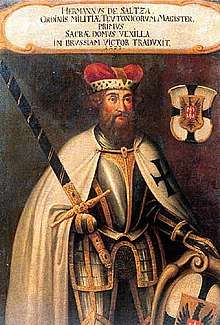
.svg.png)
The Black Cross (Schwarzes Kreuz) is the emblem used by the Prussian Army, and by the army of Germany from 1871 to present. It was designed on the occasion of the German Campaign of 1813, when Friedrich Wilhelm III of Prussia commissioned the Iron Cross as the first military decoration open to all ranks, including enlisted men. From this time, the Black Cross was featured on the Prussian war flag alongside the Black Eagle. It was designed by neoclassical architect Karl Friedrich Schinkel, based on a sketch by Friedrich Wilhelm III[3] The design is ultimately derivative of the black cross used by the Teutonic Order. This heraldic cross took various forms throughout the order's history, including a simple Latin cross, a cross potent, cross fleury and occasionally also a cross pattée.
When the Quadriga of the Goddess of Peace was retrieved from Paris at Napoleon's fall, it was re-established atop Berlin's Brandenburg Gate. An Iron Cross was inserted into Peace's laurel wreath, making her into a Goddess of Victory. In 1821 Schinkel crowned the top of his design of the National Monument for the Liberation Wars with an Iron Cross, becoming name-giving as Kreuzberg (cross mountain) for the hill it stands on and – 100 years later – for the homonymous quarter adjacent to it.[4]
The Black Cross was used on the naval and combat flags of the German Empire. The Black Cross was used as the symbol of the German Army until 1915, when it was replaced by a simpler Balkenkreuz. The Reichswehr of the Weimar Republic (1921–35), the Wehrmacht of Nazi Germany (1935–46) and the Bundeswehr (1 October 1956 to present) also inherited use of the emblem in various forms. The traditional design in black is used on armored vehicles and aircraft, while after German reunification, a new design in blue and silver was introduced for use in other contexts.
Medal and ribbon design
The ribbon for the 1813, 1870 and 1914 Iron Cross (2nd Class) was black with two thin white bands, the colors of Prussia. The non-combatant version of this award had the same medal, but the black and white colors on the ribbon were reversed. The ribbon color for the 1939 EKII was black/white/red/white/black.
Since the Iron Cross was issued over several different periods of German history, it was annotated with the year indicating the era in which it was issued. For example, an Iron Cross from World War I bears the year "1914", while the same decoration from World War II is annotated "1939". The reverse of the 1870, 1914 and 1939 series of Iron Crosses have the year "1813" appearing on the lower arm, symbolizing the year the award was created. The 1813 decoration also has the initials "FW" for King Friedrich Wilhelm III, while the next two have a "W" for the respective kaisers, Wilhelm I and Wilhelm II. The final version shows a swastika. There was also the "1957" issue, a replacement medal for holders of the 1939 series which substituted an oak-leaf cluster for the banned swastika.
When the Iron Cross was reauthorized for World War I in 1914, it was possible for individuals who had previously been awarded one in 1870 to be subsequently granted another. These recipients were recognized with the award of a clasp featuring a miniaturized 1914 Iron Cross on a metal bar.[5] The award was quite rare, since by this time there were few in service who held the 1870 Iron Cross. In World War II it was also possible for a holder of the 1914 Iron Cross to be awarded a second or higher grade of the 1939 Iron Cross. In such cases, a "1939 Clasp" (Spange) would be worn on the original 1914 Iron Cross. For the 1st Class award, the Spange appears as an eagle with the date "1939". This was pinned to the uniform above the original medal. Although they were two separate awards in some cases the holders soldered them together.
A cross has been the symbol of Germany's armed forces (now the Bundeswehr) since 1871.
Original awards of the Wars of Liberation
.png)
.jpg)
.jpg)
On 17 March 1813 King Frederick William III of Prussia – who had fled to non-occupied Breslau (today Wrocław) – established the military decoration of the Iron Cross, backdated to 10 March (the late Queen Louise's birthday).[6] The Iron Cross was awarded to soldiers during the Wars of Liberation against Napoleon. Before a soldier could be awarded with the Iron Cross 1st Class, he needed to have been decorated with the Iron Cross 2nd Class.[1] It was first awarded to Karl August Ferdinand von Borcke on 21 April 1813.[7] The first form of the Iron Crosses 1st Class were stitched in ribbon to the left uniform breast. By order of 1 June 1813, the 2nd form was created in cast iron with silver borders, and 8 loops on the reverse, to be fixed to the left uniform breast. In 1817 a total of 670 chevaliers had received the Iron Cross 1st Class.[8]
The recommissioned Iron Cross for the Franco-Prussian War
King Wilhelm I of Prussia authorized further awards on 19 July 1870, during the Franco-Prussian War. Recipients of the 1870 Iron Cross who were still in service in 1895 were authorized to purchase and wear above the cross a Jubiläumsspange ("Jubilee clip"), a 25-year clasp consisting of the numerals "25" on three oak leaves.[5]
World War I
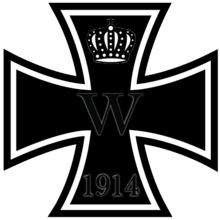
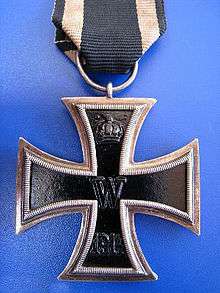
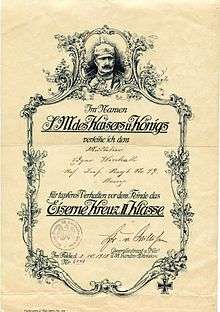
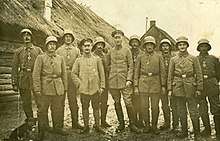
Emperor Wilhelm II reauthorized the Iron Cross on 5 August 1914, at the start of World War I. During these three periods, the Iron Cross was an award of the Kingdom of Prussia, although—given Prussia's pre-eminent place in the German Empire formed in 1871—it tended to be treated as a generic German decoration. The 1813, 1870, and 1914 Iron Crosses had three grades:
- Iron Cross 2nd Class (Eisernes Kreuz 2. Klasse, or EKII)
- Iron Cross 1st Class (Eisernes Kreuz 1. Klasse, or EKI)
- Grand Cross of the Iron Cross (Großkreuz des Eisernen Kreuzes, often simply Großkreuz)
Although the obverse of the medals of each class was identical, the manner in which each was worn differed. The Iron Cross 1st Class employed a pin or screw posts on the back of the medal, and was worn on the left side of the recipient's uniform, like the original 1813 version. The Iron Cross 2nd Class, and the larger Grand Cross, were suspended from different ribbons: the Grand Cross from a neck ribbon, the 2nd Class from a ribbon on the chest. The usual display of the 2nd Class version was as a ribbon through one of the button holes in the recipient's tunic.
The Grand Cross was intended for senior generals of the Prussian or (later) the German Army. An even higher decoration, the Star of the Grand Cross of the Iron Cross (also called the Blücher Star), was awarded only twice, to Generalfeldmarschall Gebhard Leberecht von Blücher in 1813 and to Generalfeldmarschall Paul von Hindenburg in 1918. A third award was planned for the most successful German general during World War II, but was not made after the defeat of Germany in 1945.
The Iron Cross 1st Class and the Iron Cross 2nd Class were awarded without regard to rank. One had to possess the 2nd Class already in order to receive the 1st Class (though in some cases both could be awarded simultaneously). The egalitarian nature of this award contrasted with those of most other German states (and indeed of many other European monarchies), where military decorations were awarded based on the rank of the recipient. For example, Bavarian officers received various grades of that Kingdom's Military Merit Order (Militär-Verdienstorden), while enlisted men received various grades of the Military Merit Cross (Militär-Verdienstkreuz). Prussia did have other orders and medals which it awarded on the basis of rank, and even though the Iron Cross was intended to be awarded without regard to rank, officers and NCOs were more likely to receive it than junior enlisted soldiers.
During World War I, approximately 218,000 EKIs, 5,196,000 EKIIs and 13,000 non-combatant EKIIs were awarded.[9] Exact numbers of awards are not known, since the Prussian military archives were destroyed during World War II. The multitude of awards reduced the status and reputation of the decoration. Among the holders of the 1914 Iron Cross 2nd Class and 1st Class was Adolf Hitler, who served as an Austrian citizen in the Bavarian Army with the rank of Gefreiter (lance-corporal), he received these medals for showing bravery on the field of battle.[10] Most photographs of Hitler show him wearing his EKI in standard fashion on his left breast.
Allied Propaganda versions
In 1914, a variety of very crude anti-German propaganda versions of the Iron Cross were created by the Allies, and sold to raise money for the War effort and the relief of Belgian refugees. One was inscribed "FOR KULTUR" in raised letters, another "FOR BRUTALITY" . Yet another showed the names of French and Belgian towns attacked or destroyed during the retreat from Mons on the ends of the upper arms of the cross; these included Rheims, Louvain and Amiens on one side, and Antwerp, Dinant and Ghent on the other, with the date 1914 on the lower arm, and a central W for Kaiser Wilhelm as on the original. Another commemorated the raid on Scarborough, Hartlepool and Whitby, showing the names of these "war atrocities" on the arms of the cross.
World War II
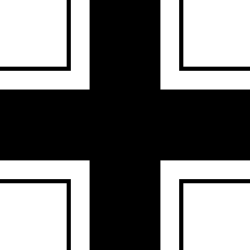
.svg.png)
Adolf Hitler restored the Iron Cross in 1939 as a German decoration (rather than Prussian), and continued the tradition of issuing it in various classes. Legally, it is based on the "Enactment for the re-introduction of the Iron Cross" (Verordnung über die Erneuerung des Eisernen Kreuzes) of 1 September 1939.[11] The Iron Cross of World War II was divided into three main series of decorations with an intermediate category, the Knight's Cross, instituted between the lowest, the Iron Cross, and the highest, the Grand Cross. The Knight's Cross replaced the Prussian Pour le Mérite or "Blue Max". Hitler did not care for the Pour le Mérite, as it was a Prussian order that could be awarded only to officers. The ribbon of the medal (2nd class and Knight's Cross) was different from the earlier Iron Crosses as the color red was used in addition to the traditional black and white (black and white were the colors of Prussia, while black, white, and red were the colors of Nazi Germany). Hitler also created the War Merit Cross as a replacement for the non-combatant version of the Iron Cross. It also appeared on certain Nazi flags in the upper left corner. The sides of the cross were curved, like most original iron crosses.
Iron Cross
| Iron Cross 2nd Class | ||||
|---|---|---|---|---|
| Iron Cross 1st Class | |||
|---|---|---|---|
| Knight's Cross of the Iron Cross | ||||
|---|---|---|---|---|
| Grand Cross of the Iron Cross | |
|---|---|
The standard 1939 Iron Cross was issued in the following two grades:
- Iron Cross 2nd Class (Eisernes Kreuz 2. Klasse - abbreviated as EK II or E.K.II.)
- Iron Cross 1st Class (Eisernes Kreuz 1. Klasse - abbreviated as EK I or E.K.I.)
The Iron Cross was awarded for bravery in battle as well as other military contributions in a battlefield environment.
The Iron Cross 2nd Class came with a ribbon and the cross itself was worn in one of two different ways:
- From the second button in the tunic for the first day after award.
- When in formal dress, the entire cross was worn mounted alone or as part of a medal bar.
Note that for everyday wear, only the ribbon itself was worn from the second buttonhole in the tunic.
The Iron Cross 1st Class was a pin-on medal with no ribbon and was worn centered on a uniform breast pocket, either on dress uniforms or everyday outfit. It was a progressive award, with the second class having to be earned before the first class and so on for the higher degrees.
It is estimated that some four and a half million 2nd Class Iron Crosses were awarded during World War II, and 300,000 of the 1st Class.[12] Two Iron Cross 1st Class recipients were women, one of whom was test pilot Hanna Reitsch. One of the Muslim SS members to receive the award, SS Obersturmführer Imam Halim Malkoć, was granted the Iron Cross (2nd Class) in October 1943 for his role in suppressing the Villefranche-de-Rouergue mutiny. He, together with several other Bosnian Muslims, was decorated with the EK. II personally by Himmler in the days after the mutiny. Because of his Muslim faith, he only wore the ribbon, and not the cross. Two Jewish officers of the Finnish Army, including Major Leo Skurnik, and one female Lotta Svärd member were awarded Iron Crosses, but they would not accept them.[13] The Spanish double-agent Juan Pujol García, known to the Germans as Arabel and the British as Garbo received the 2nd Class Iron Cross,[14] and an MBE from King George VI four months later.[15] William Manley is possibly the only recipient of both the Iron Cross and the Victoria Cross. He was awarded the Iron Cross for service with an ambulance unit in the Franco-Prussian War of 1870–71.[16]
Knight's Cross of the Iron Cross
.jpg)
The Knight's Cross of the Iron Cross (Ritterkreuz des Eisernen Kreuzes, often simply Ritterkreuz) recognized military valour or successful leadership. The Knight's Cross was divided into five degrees:
- Knight's Cross (Ritterkreuz des Eisernen Kreuzes)
- Knight's Cross with Oak Leaves (mit Eichenlaub)
- Knight's Cross with Oak Leaves and Swords (mit Eichenlaub und Schwertern)
- Knight's Cross with Oak Leaves, Swords, and Diamonds (mit Eichenlaub, Schwertern und Brillanten)
- Knight's Cross with Golden Oak Leaves, Swords, and Diamonds (mit Goldenem Eichenlaub, Schwertern und Brillanten)
In total, 7,313 awards of the Knight's Cross were made. Only 883 received the Oak Leaves; 160 both the Oak Leaves and Swords (including Japanese Admiral Isoroku Yamamoto (posthumously)); 27 with Oak Leaves, Swords and Diamonds; and one with the Golden Oak Leaves, Swords, and Diamonds (Oberst Hans-Ulrich Rudel).
Grand Cross of the Iron Cross (1939)
Like the Knight's Cross, the Grand Cross (Großkreuz) was worn suspended from the collar. It was reserved for general officers for "the most outstanding strategic decisions affecting the course of the war". The only recipient during the Second World War was Reichsmarschall Hermann Göring, who was awarded the decoration on 19 July 1940 for his command of the Luftwaffe, after the Battle of France in 1940.[17]
The medal is a larger version of the Knight's Cross,[18] measuring 63 mm (2.5 in) wide as opposed to about 44 mm (1.7 in) for the Iron Cross and 48.5 mm (1.9 in) for the Knight's Cross. It was originally intended to have outer edges lined in gold, but this was changed to silver before the award was presented. It was worn with a 57 mm (2.2 in) wide ribbon bearing the same colors as the Knight's Cross and 2nd Class ribbons.[17] The award case was in red leather with the eagle and the swastika outlined in gold.
The original Grand Cross presented to Göring (personally by Hitler) was destroyed during an air raid on his Berlin home. Göring had extra copies made, one of them with a platinum frame that he was wearing at the time of his surrender to the allies in 1945.[17]
Star of the Grand Cross of the Iron Cross (1939)
.jpg)
The Star of the Grand Cross of the Iron Cross (also called Iron Cross with Golden Rays) was pinned to the left breast, above the Iron Cross 1st Class. Like the Grand Cross of the Iron Cross, it was for bestowal upon successful general officers.[18]
The Star of the Grand Cross was awarded only twice, both to Field Marshals who already held the Grand Cross: in 1815 to Gebhard von Blücher for his part in the Battle of Waterloo, and in March 1918 to Paul von Hindenburg for his conduct of the 1918 Spring Offensive on the Western Front.[18] It is often called the Blücher Star (Blücherstern), after its first recipient.[19]
A Star of the Grand Cross of the Iron Cross was manufactured in World War II, but never formally instituted or awarded. The only known example, based on the World War I version but with the 1939 Iron Cross centerpiece, was found by Allied forces at the end of the war, and it is now in the museum at West Point.[20] It is likely that Reichsmarschall Göring was the intended eventual recipient. He was the only holder of the World War II Iron Cross Grand Cross, and both the previous recipients of the Star had already received the Grand Cross.
Side features of the Iron Cross and entitlements
Officers awarded the Iron Cross were given entitlements and often wore signifying articles, such as an Iron Cross signet ring or cloth Iron Cross which could be affixed to clothing. Also, during the Nazi period, those attaining more than one award, for example, an officer who had attained an Iron Cross 1st Class, an Iron Cross 2nd Class and the Knight's Cross of the Iron Cross with the Oak Leaves, were entitled to wear a pin which exhibited three Iron Crosses with an exaggerated swastika, thereby consolidating the awards.
In some cases, Minox miniature cameras were given to people together with an Iron Cross.[21]
Post–World War II
As modern German law prohibits the production of items containing Nazi insignia, the West German government authorized replacement Iron Crosses in 1957 with an Oak Leaf Cluster in place of the swastika, similar to the Iron Crosses of 1813, 1870, and 1914, which could be worn by World War II Iron Cross recipients. The 1957 law also authorized de-Nazified versions of most other World War II–era decorations (except those specifically associated with Nazi Party organizations, such as SS Long Service medals, or with the expansion of the German Reich, such as the medals for the annexation of Austria, the Sudetenland, and the Memel region).
After post-war German armed forces began seeing active service, first in Kosovo and then in Afghanistan, a campaign began to revive the Iron Cross and other military medals, since Germany had no awards specifically for active military service. In 2007, a petition to the German parliament to revive the Iron Cross decoration was initiated, quickly receiving over 5,000 signatures. On 13 December 2007 parliament decided to let the Ministry of Defence decide the matter.[22] On 6 March 2008, President Horst Köhler approved a proposal by Minister of Defense Franz Josef Jung to institute a new award for bravery. The Ehrenzeichen der Bundeswehr (Badge of Honor of the German Armed Forces) series was instituted on 10 October 2008. However, it does not have the traditional form of the Iron Cross (instead more closely resembling the Prussian Military Merit Cross), but is seen as a supplement of existing awards of the Bundeswehr.[23]
In the United States, the Iron Cross also became adopted by outlaw bikers, more to signify rebellion or to shock than for any white nationalist ideology. By the early 2000s, this other use of the Iron Cross had spread from bikers to skateboarders and many extreme sports enthusiasts and became part of the logo of several different clothing companies.[24]
 Emblem of the Bundeswehr (since 1956)
Emblem of the Bundeswehr (since 1956).svg.png) The 1957 version of the 1939 Iron Cross with oak leaves replacing the swastika
The 1957 version of the 1939 Iron Cross with oak leaves replacing the swastika Badge of Honor of the German Armed Forces
Badge of Honor of the German Armed Forces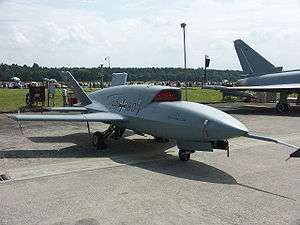 Iron Cross insignia on a UAV Barracuda
Iron Cross insignia on a UAV Barracuda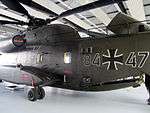 Iron Cross insignia on a German Air Force CH-53G in 2015
Iron Cross insignia on a German Air Force CH-53G in 2015
See also
- Grand Cross of the Iron Cross
- Star of the Grand Cross of the Iron Cross
- Knight's Cross of the Iron Cross
- 1939 Clasp to the 1914 Iron Cross
- Orders, decorations, and medals of Imperial Germany
- Orders, decorations, and medals of Nazi Germany
- Black Cross (Teutonic Order)
- Cross pattée
- Cross of the Warsaw Uprising (Krzyż Powstania Warszawskiego)
- Oxalis tetraphylla (a common name is Iron Cross)
Notes
- "Eisernes Kreuz 1813 - 1.Klasse" (in German). Militaria Lexikon. Retrieved 28 October 2016.
- Jean-Denis Lepage. Medieval armies and weapons in western Europe: an illustrated history. McFarland & Company, Inc., 2005. Pp. 193.
- Michael Nungesser, Das Denkmal auf dem Kreuzberg von Karl Friedrich Schinkel, ed. on behalf of the Bezirksamt Kreuzberg von Berlin as catalogue of the exhibition „Das Denkmal auf dem Kreuzberg von Karl Friedrich Schinkel“ in the Kunstamt Kreuzberg / Künstlerhaus Bethanien Berlin, between 25 April and 7 June 1987, Berlin: Arenhövel, 1987, pp. 22 and 29. ISBN 3-922912-19-2.
- Klaus-Dieter Wille, Spaziergänge in Kreuzberg, Berlin: Haude & Spener, 1986, (=Berliner Kaleidoskop: Schriften zur Berliner Kunst- und Kulturgeschichte; vol. 32), p. 21. ISBN 3-7759-0287-2.
- "Eisernes Kreuz". Dhm.de. 31 October 2011. Retrieved 23 May 2013.
- Michael Nungesser. Das Denkmal auf dem Kreuzberg von Karl Friedrich Schinkel, ed. on behalf of the Bezirksamt Kreuzberg von Berlin as catalogue of the exhibition "Das Denkmal auf dem Kreuzberg von Karl Friedrich Schinkel" in the Kunstamt Kreuzberg / Künstlerhaus Bethanien Berlin, between 25 April and 7 June 1987, Berlin: Arenhövel, 1987, p. 29. ISBN 3-922912-19-2.
- Borcke's Biography Archived 8 July 2011 at the Wayback Machine
- v. Heyden, Hermann (1897). "26. Preussen". Ehren-Zeichen (in German). Frankfurt a. M.: Heinrich Keller. p. 134.
- Stein, Hans-Peter (1991). Military History Research Office (Germany) (ed.). Symbole und Zeremoniell in deutschen Streitkräften vom 18. bis zum 20. Jahrhundert [Symbols and Military Ceremonies in the German Armed Forces from the 18th to the 20th Century] (in German). Hans-Martin Ottmer (contributor), Military History Research Office (Germany) (editing) (2 ed.). Herford: E. S. Mittler. p. 59. ISBN 3-89350-341-2. OCLC 444548272.
- Shirer 1960, p. 30.
- Reichsgesetzblatt Teil I Nr. 159, 1 September 1939, p. 1573.
- Stephen Previtera, The Iron Time, p. 322
- Rachel Bayvel (2006). "'While Jews serve in my army I will not allow their deportation'". Jewish Quarterly. Archived from the original on 11 March 2012. Retrieved 24 December 2011.
- West, Juan Pujol with Nigel (1985). Operation GARBO: the personal story of the most successful double agent of World War II (1st American ed.). New York: Random House. p. 159. ISBN 978-0-394-54777-0.
- The National Archives. "Security Service Records Release 25–26 November 2002" (PDF). The National Archives (UK). Retrieved 10 January 2012.
25 November Garbo received MBE from King
- "Obituary: Surgeon-General W.G.N. Manley, V.C." London Medical Press and Circular. 123: 584–585. 27 November 1901.
- Littlejohn & Dodkins 1968, p. 117.
- Dorling 1956, pp. 210-211.
- Zabecki 2014, p. 1628.
- Littlejohn & Dodkins 1968, p. 120.
- Postimees 23 May 2009: Eesti kõige edukamad leiutised
- "'Kein Eisernes Kreuz': Köhler für Tapferkeitsorden - Inland". FAZ. 6 March 2008. Retrieved 23 May 2013.
- "Iron Cross". Anti-Defamation League.
References
- Dorling, Captain H. Taprell (1956). Ribbons and Medals. A.H.Baldwin & Sons, London.CS1 maint: ref=harv (link)
- Littlejohn, David; Dodkins, Colonel C. M. (1968). Orders, Decorations, Medals and Badges of the Third Reich. R. James Bender Publishing, California. ISBN 978-0854200801.CS1 maint: ref=harv (link)
- Maerz, Dietrich/Stimson, George "The Iron Cross 1. Class", 2010, ISBN 978-0-9797969-7-5
- Maerz, Dietrich, "Award Numbers of the Iron Cross of 1939", International Medal Collector, Vol.3-No.4 and Vol. 4-No.s, ISSN 2152-9310
- Previtera,Stephen Thomas, The Iron Time: A History of the Iron Cross, Second edition 2007, ISBN 978-0-9673070-3-9
- Williamson, Gordon, The Iron Cross of 1939, 1997, ISBN 0-912138-86-6
- Zabecki, David T., ed. (2014). Germany at War: 400 Years of Military History. Santa Barbara: ABC-CLIO. ISBN 9781598849813.CS1 maint: ref=harv (link)
Bibliography
- Shirer, William L. (1960). The Rise and Fall of the Third Reich. New York: Simon & Schuster. ISBN 978-0-671-62420-0.CS1 maint: ref=harv (link)
External links
| Wikimedia Commons has media related to Iron Cross. |
- German Ministry of Defence (BMVg) on the Iron Cross.
- Iron Cross 1914 (Eisernes Kreuz 1914)
- . New International Encyclopedia. 1905.
